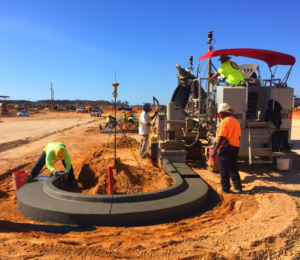
Small landscape or short length curb on pavement applications can be completed with small hand-steered extruder models, where the compaction of the concrete out of a screw auger propels the machine forward. This is only really viable for pouring on hard asphalt or concrete. If you try on subbase that is not compacted and firm, the machine could get bogged down in soft spots.
Much larger volume residential, commercial, and road reconstruction applications steer operators towards self-propelled concrete curb machines.
Things to Look for in a Curb Machine
- Ability and Ease of Use: First, ensure the machine has the ability to turn and pour the required curb radius and profiles for your jobs. You should also consider the ease of setup and machine features to handle job conditions well. Finally, think about the ease and safety of transport and loading/unloading, since you’ll be traveling often to various sites and time savings is key.
- Manufacturer and/or Dealer Support: When it comes to maintenance and repairs, it’s not a matter of if, but when – can you get the help you need quickly to minimize downtime? Will they be available and local to help when something goes wrong?
- Adaptability and Size: Can the machine do more as your business grows? Weight matters in a curb machine to efficiently extrude at a decent production rate. You’ll also want to consider adaptability to use stringline, or go stringless with 3D grade control systems such as Topcon, Leica, or Trimble.
- Safety: There are lots of moving parts when pouring, so the machine must be simple to set up and run, and be safe for all crew members around the unit. Visibility is also key to ensuring safety: can the operator and crew see each other well?
- Time-Saving Features: To improve efficiency, look for features like quick connect molds and offset mold locks that can save a lot of non-productive time.
- Resale Value: When it comes time to upgrade, is the machine make going to hold its value? Do your research to ensure you’re buying a quality brand that will provide the best return on investment.
- New, Used, or Factory Rebuilt: If your business absolutely depends on the reliability of this machine day in and day out, then if at all possible, look for a new or as a second choice, factory rebuilt unit. If you can accept and can work around possible downtime, a used unit can save you capital but still achieve what you want to do.
If you’d like to discuss your operations and suitability for automating your curb operations with a machine, get in touch with us. We will point you in the right direction with additional resources and considerations, helping you to make an informed decision about your curbing equipment.
Amaco is Ontario’s heavy equipment specialist and has helped municipalities, contractors, and owner-operators across the province find the right machine solutions for them. Contact us today to discuss your needs!
Read more from Amaco:
- Don’t Just Advertise You Have Potholes – Fix Them!
- A Guide to Choosing the Right Heavy Equipment Solutions
- 6 Things You Can Do to Keep Road Workers Safe
- 8 Questions To Ask When Buying Used Aggregate Equipment - June 16, 2025
- 5 Key Steps to Choosing the Right Curb Machine for Your Fleet - October 22, 2024
- 5 Tips for Purchasing Used Excavating Equipment in Ontario - September 26, 2024

